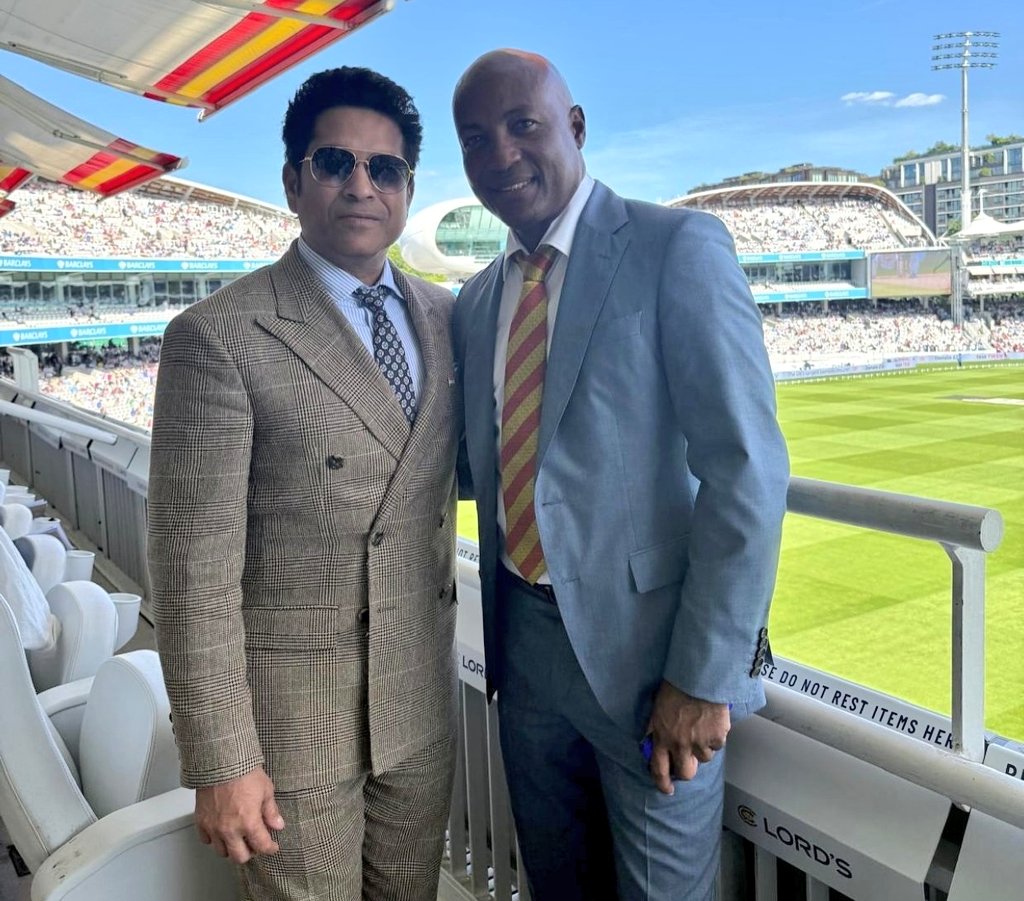Loading…

Brian Lara Debut, Biography, Stats, Net Worth, Wife, IPL Team, Records, Career
4.7 (27) There are few names in the world of cricket that evoke more admiration and memories than Brian Charles Lara. Known as the “Prince of Port of Spain”, Lara’s batting, timing and record-breaking feats made him one of the greatest batsmen to ever play the game. His journey from a small town in Trinidad […]

There are few names in the world of cricket that evoke more admiration and memories than Brian Charles Lara. Known as the “Prince of Port of Spain”, Lara’s batting, timing and record-breaking feats made him one of the greatest batsmen to ever play the game. His journey from a small town in Trinidad to becoming a global icon of cricket is a story of talent, perseverance and unwavering confidence.
Early Life And Education
Brian Charles Lara was born on May 2, 1969, in Cantaro, Santa Cruz, Trinidad. The tenth of eleven children, Lara grew up in a modest family that placed great importance on sports. His father and one of his elder sisters encouraged him to take cricket seriously at an early age. He studied at Fatima College in Trinidad, where he began to hone his cricketing skills under structured coaching.
Apart from cricket, Lara also showcased his athleticism in football and table tennis for the junior teams of Trinidad. However, cricket was his real name. His unique batting style began to attract attention even in his teenage years.
Brian Lara’s Beginnings and Rise to Stardom
Lara’s domestic career began with Trinidad and Tobago, and at the tender age of 20, he became the youngest captain of the team in 1990. That same year, he made his Test debut against Pakistan, scoring 44 and 6. While his debut was mediocre, it hinted at the potential of a future great.
A year later, he also made his One Day International (ODI) debut against Pakistan. And he began a career that would soon change the landscape of batting.
It didn’t take long for Lara to capture the imagination of the cricketing world. His talent, brilliance and consistency earned him comparisons to greats like Don Bradman and Garry Sobers.
Brian Lara’s record-breaking exploits
In 1994, Lara carved his name into cricketing folklore. Within two months, he broke two of cricket’s biggest records:
- 375 against England in Antigua, the highest individual score in Test cricket at the time.
- 501 not out for Warwickshire in county cricket, the highest score in first-class cricket history, a record that still stands.
These achievements established Lara as the undisputed king of monumental innings. His ability to score huge scores while maintaining a grand style made him a global superstar.
Even as captain, Lara continued to produce innings of unparalleled brilliance, even when his teams often struggled. His 153 against Australia in Barbados in 1999 is still considered one of the greatest match-winning innings in Test history.
400 Not Out – a Record Reclaimed
In 2004, when critics began to question his form, Lara responded with a historic performance. Against England in Antigua, he scored an unbeaten 400. There he became the first player to reclaim the world record for the highest individual Test score.
This innings not only confirmed his talent but also demonstrated his mental strength. It is a reminder that, when in form, Lara was almost unbeaten.
Read Also: Sir Don Bradman Debut, Biography, Stats, Net Worth, Wife, IPL Team, Records, Career
Captaincy And Challenges
Lara’s tenure as captain was often turbulent. He led a West Indies team that was struggling with inconsistency and internal disputes. Yet, amidst the chaos, he remained their brightest hope.
He led the West Indies on difficult tours, including to South Africa (2003) and England (2004), but the results were often not in his favour. Despite these challenges, under Lara’s leadership, the West Indies won the ODI series against India 4–1 in 2006.
However, his second stint as captain showed how much pressure was on him. Lack of support and administrative struggles eventually led to his retirement in 2007. Shortly after the ICC World Cup, a golden era came to an end.
Source: X.com
Career Statistics
Batting and Fielding
| Format | Mat | Inns | NO | Runs | HS | Ave | BF | SR | 100s | 50s | 4s | 6s | Ct | St |
|---|---|---|---|---|---|---|---|---|---|---|---|---|---|---|
| Tests | 131 | 232 | 6 | 11,953 | 400* | 52.88 | 19,753 | 60.51 | 34 | 48 | 1,559 | 88 | 164 | 0 |
| ODIs | 299 | 289 | 32 | 10,405 | 169 | 40.48 | 13,086 | 79.51 | 19 | 63 | 1,042 | 133 | 120 | 0 |
| First-Class (FC) | 261 | 440 | 13 | 22,156 | 501* | 51.88 | – | – | 65 | 88 | – | – | 320 | 0 |
| List A | 429 | 411 | 43 | 14,602 | 169 | 39.67 | – | – | 27 | 86 | – | – | 177 | 0 |
| T20s | 3 | 3 | 0 | 99 | 65 | 33.00 | 86 | 115.11 | 0 | 1 | 11 | 1 | 0 | 0 |
Bowling
| Format | Mat | Inns | Balls | Runs | Wkts | BBI | BBM | Ave | Econ | SR | 4w | 5w | 10w |
|---|---|---|---|---|---|---|---|---|---|---|---|---|---|
| Tests | 131 | 4 | 60 | 28 | 0 | – | – | – | 2.80 | – | 0 | 0 | 0 |
| ODIs | 299 | 5 | 49 | 61 | 4 | 2/5 | 2/5 | 15.25 | 7.46 | 12.2 | 0 | 0 | 0 |
| First-Class (FC) | 261 | – | 514 | 416 | 4 | 1/1 | – | 104.00 | 4.85 | 128.5 | – | 0 | 0 |
| List A | 429 | – | 130 | 149 | 5 | 2/5 | 2/5 | 29.80 | 6.87 | 26.0 | 0 | 0 | 0 |
| T20s | 3 | – | – | – | – | – | – | – | – | – | – | – | – |
Lara is one of only three players to have scored two Test triple centuries (the others being Don Bradman and Virender Sehwag). His name is synonymous with class, concentration and cricketing artistry.
Brian Lara’s Playing Style
Lara’s batting was a blend of artistry and aggression. His high backlift allowed him to generate immense power, while his precise footwork made him deadly against both pace and spin. Watching Lara bat was an aesthetic experience, every cover drive and late cut was pure poetry in motion.
He had a unique ability to dominate world-class bowlers. Whether facing Glenn McGrath, Shane Warne, or Muttiah Muralitharan, Lara often found ways to outscore and outscore them. His innings were not just about runs, they were statements of intent and grandeur.
Brian Lara Net Worth
As of 2025, Brian Lara has an estimated net worth of $60 million (USD). His sources of income include:
- Cricket earnings and match fees
- Brand endorsements and sponsorships
- Commentary and analysis roles
- Business ventures and investments
He has also worked as a brand ambassador for luxury watches, sports brands, and charities. Lara’s financial success reflects both his greatness on the field and his popularity around the world.
Brian Lara’s Wife And Personal Life
Brian Lara has always kept his personal life relatively private. He was in a long-term relationship with Trinidadian journalist and model Liesl Rowedas. The couple has two daughters, named Sydney Lara and Tyla Lara.
Off the field, Lara is known for his charm, humility, and deep love of music and golf. He is a beloved figure in Trinidad and the Caribbean. He is also often seen at charity events, especially those related to youth sports.
Brian Lara And The IPL
Although Lara retired before the IPL actually began, his influence on modern T20 batsmen is undeniable. Many players, including Virat Kohli, AB de Villiers and Chris Gayle, have cited Lara as an inspiration for their batting and mental strength.
He later served as a batting consultant and mentor for IPL franchises such as Sunrisers Hyderabad. His experience there helped guide young talents to improve their technique and temperament.
Legacy And Impact on Cricket
Brian Lara’s impact on cricket went beyond numbers. He represented the hope of an entire region. Even when the team was struggling, Lara’s individual brilliance brought fans to the stadium and kept viewers glued to their screens.
His ability to stand tall against the world’s best attacks made him a symbol of resilience. To this day, young cricketers study his innings to understand balance, timing and determination.
In 2012, he was inducted into the ICC Hall of Fame, a recognition of his invaluable contribution to the game. The stadium still echoes with chants of “Lara! Lara!” whenever a classic batting performance is displayed.
Conclusion
Brian Charles Lara’s journey is a story of artistry, perseverance and unparalleled passion for the game. His legacy is etched in the golden treasury of cricket, not just for the runs he scored but also for his beauty. From his debut in 1990 to his retirement in 2007, Lara inspired the next wave of batting talents.
In every sense, Brian Lara has been the eternal prince of cricket, always majestic, fearless and unforgettable!
FAQs
Q1. When did Brian Lara make his international debut?
Brian Lara made his Test debut on December 6, 1990 and ODI debut on November 9, 1990, both against Pakistan.
Q2. What is Brian Lara’s highest score in Test cricket?
His highest Test score is an unbeaten 400 against England at Antigua in 2004.
Q3. Did Brian Lara play in the IPL?
No, Brian Lara retired before the IPL started. However, he later worked as a batting consultant for Sunrisers Hyderabad.
Q4. Who is Brian Lara’s wife?
Brian Lara is in a relationship with Trinidadian model and journalist Liesl Rowedas. They have two daughters.
Q5. What will be Brian Lara’s net worth in 2025?
As of 2025, Brian Lara’s net worth is estimated to be around $60 million USD from cricket, endorsements, and business ventures.
Cricbites provides live cricket scores, simple cricket stories, player profiles, records, match facts and updates. The blog aims to provide simple cricket knowledge to fans who enjoy reading about the game.

